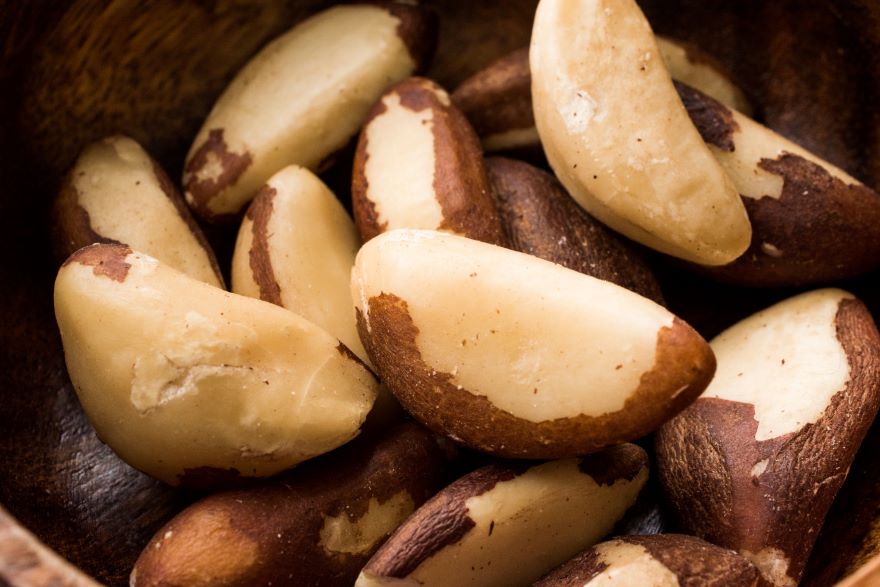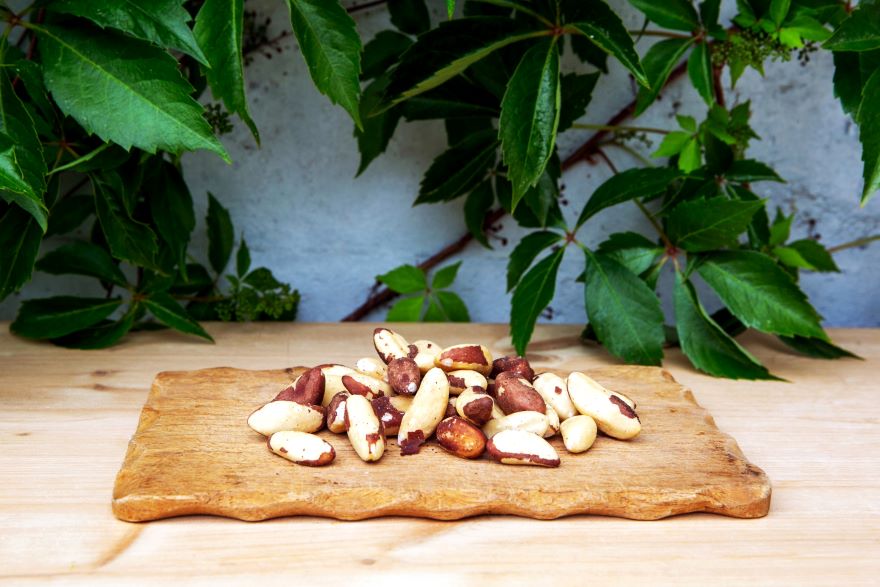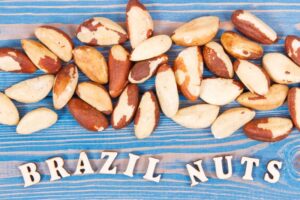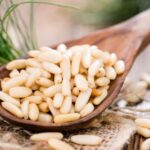Brazil Nuts Raw
Brazil nuts, native to the Amazon rainforest, are an incredibly nutritious and versatile food. Brazil nuts are rich in selenium and other essential nutrients, and have been a part of human diets for centuries. Consuming raw Brazil nuts is the healthiest way to enjoy them, as it preserves their nutritional content and unique flavor.
South American indigenous communities harvested Brazil nuts for centuries. Raw Brazil nuts are high in healthy fats, proteins, and fiber, and contain potassium, calcium, and magnesium. Use Brazil nuts in snacks, salads, desserts, and more.
When buying Brazil nuts, it’s essential to consider their quality and freshness to ensure optimal taste and nutrition. Store Brazil nuts properly to prevent spoiling.

Key Takeaways
Raw Brazil nuts are a nutritious and versatile food with a rich history originating from the Amazon rainforest.
They boast an impressive nutritional profile, containing essential nutrients such as selenium, healthy fats, and dietary fiber.
Proper selection and storage of Brazil nuts are crucial to maintaining their taste and nutritional value.
History of Brazil Nuts
As a lover of Brazil nuts, I find it fascinating to delve into their history. Brazil nut trees are native to the Amazon rainforest.
The history of Brazil nut harvesting goes back several centuries, with exports to Europe dating back to the mid-1600s Most of the collections occur in the regions of Acre (Brazil), Pando (Bolivia), and Madre de Dios (Peru), where it serves as a crucial source of income for local communities.
Brazil nuts had a different name in the 1930s, but nowadays, people in the Brazilian state of Pará typically call them “castanha-do-pará.” This delicious and nutritious nut has undoubtedly made its mark on history and continues to be a popular snack and ingredient in dishes all around the world.
Nutritional Profile of Raw Brazil Nuts
Vitamins and Minerals
I am fascinated by the rich nutritional profile of Brazil nuts as a lover of them. Raw Brazil nuts are an excellent source of essential vitamins and minerals. These nuts are considered the richest dietary source of the essential mineral selenium. I also appreciate that they contain significant amounts of potassium, calcium, and magnesium, which contribute to overall health and well-being.
Protein and Fat Content
Apart from vitamins and minerals, I enjoy the benefits of protein and healthy fats in raw Brazil nuts. Each serving provides approximately 4 grams of protein, which assists in maintaining a balanced diet. Furthermore, the 19 grams of fat per serving are mainly healthy fats, since they consist mainly of unsaturated fatty acids that support heart health.
Fiber Content
Lastly, I cannot ignore the fiber content in raw Brazil nuts. Each serving offers 2.1 grams of fiber, which is essential for promoting digestive health and maintaining healthy blood sugar levels. This nutrient also makes Brazil nuts a satisfying and nutritious snack option for those looking to maintain a healthy lifestyle.
Culinary Uses for Raw Brazil Nuts
In Cooking
As a cook, I’ve easily added raw Brazil nuts to different dishes as a versatile ingredient. For example, they add texture and a nutty flavor to salads. Another way I like to use raw Brazil nuts is in pesto. By swapping pine nuts with Brazil nuts, the pesto takes on a unique taste that pairs well with pasta or as a spread on sandwiches.
Additionally, raw Brazil nuts work well in warm dishes like stews, stir-fries, and pilafs. They provide a crunchy texture and their high fat content helps to create a more satisfying dish.
In Baking
In baking, I enjoy experimenting with raw Brazil nuts to create a variety of baked goods with a nutty twist. For example, by mixing crushed Brazil nuts into cookie dough, it gives an interesting flavor and texture to the final product. Incorporating raw Brazil nuts into chocolate-based recipes, such as cakes or brownies, brings out the flavor while adding to the richness of the dessert.
Also, I like making a delicious vegan cheese log using raw Brazil nuts, lemon, and rosemary recipe which appeals to both vegan and non-vegan guests. Raw Brazil nuts can also replace more traditional nuts in recipes for banana bread, oatmeal cookies, or even energy bars.
By including raw Brazil nuts into your cooking and baking, you can experiment with new flavors and textures while benefiting from their nutritional value.

Considerations when Purchasing Raw Brazil Nuts
Quality Indicator
When I buy raw Brazil nuts, I make sure to check the expiry date on the label, as this shows how long the nuts should retain their quality. Even though it’s not a strict expiration date, it helps me to ensure that the nuts I’m buying are still fresh and safe to consume. It’s important to examine the nuts as well, looking for any signs of mold, discoloration, or damage. I prefer to buy nuts that are evenly sized, have a healthy appearance, and are free from any nasty odors.
Sustainability
When it comes to sustainability, I believe in making responsible choices. That’s why I ensure that the raw Brazil nuts I buy come from a sustainable source. Since Brazil nuts are mainly harvested in the Amazon rainforest, I opt for suppliers who practice responsible harvesting methods that promote the conservation of the ecosystem. One option is to look for organic certifications or Fair Trade labels. This can indicate environmentally friendly and socially responsible practices. By doing so, I can enjoy my favorite nutritious snack while also supporting the sustainability of the Amazon rainforest.
Proper Storage of Raw Brazil Nuts
As someone who appreciates the nutritional benefits of raw Brazil nuts, I know that proper storage is crucial to preserving their quality and freshness. Here, I will share some essential tips on how to store raw Brazil nuts effectively.
Firstly, I always use airtight containers when storing Brazil nuts to prevent any moisture, air, and odors from compromising their quality. This applies whether I’m storing them at room temperature, in the refrigerator, or the freezer.
It’s important to keep the nuts in a cool and dark place, away from direct sunlight or heat sources. I’ve discovered that when stored at temperatures from +2 to +8 degrees in the refrigerator, the shelf life of Brazil nuts in a plastic bag doesn’t exceed a month. However, using an airtight container extends their shelf life to over a year.
For long-term storage, I find that freezing Brazil nuts is the best option. When placed in a freezer bag or airtight container, they can be stored in the freezer for up to two years. This method ensures that the nuts retain their nutritional value and remain fresh for an extended period.
Before storing, soaking Brazil nuts is a good idea. It helps to activate their enzymes and enhance their nutritional benefits. To do this, I submerge the nuts in water with a pinch of sea salt for around 4 to 8 hours, based on my preference.
In summary, storing raw Brazil nuts properly is essential to maintaining their freshness, quality, and nutritional benefits. By following these storage tips, I’m able to enjoy delicious and healthy Brazil nuts whenever I please.
Frequently Asked Questions
- Are Brazil nuts safe to eat raw? Yes, Brazil nuts are safe to eat raw. In fact, eating them raw allows you to fully enjoy their natural nutrients and flavors. Just make sure to handle and store them properly to prevent bacterial contamination and spoilage. However, it’s important to be aware of potential allergies and not overconsume them due to their high selenium content.
- Where can I buy raw Brazil nuts? Raw Brazil nuts can be found at various locations, such as supermarkets, health food stores, and online retailers. Buying from a reputable source ensures good quality and proper storage.
- What is the selenium content in Brazil nuts? Brazil nuts are well-known for their high selenium content. One Brazil nut can contain up to 68-91 micrograms of selenium, which is more than the daily recommended allowance. However, the selenium content can vary depending on factors like soil conditions and nut size.
- How do you prepare raw Brazil nuts for eating? You can choose to eat raw Brazil nuts as is, or you may want to activate them first by soaking and dehydrating them to enhance their nutritional value and improve their digestibility. Brazil nuts can be eaten on their own, added to trail mixes, or used as a topping for yogurt, oatmeal, and salads.
- Can raw Brazil nuts be found at grocery stores? Indeed, raw Brazil nuts can be found in the nuts and seeds section of most grocery stores. Just make sure to look for fresh and properly stored nuts to guarantee their quality and nutritional value.
- What are the health benefits of consuming raw Brazil nuts? Raw Brazil nuts offer various health benefits due to their rich nutrient profile, which includes selenium, magnesium, and thiamine. These nutrients promote thyroid, heart, and brain health, as well as boost immunity, aid in weight loss, and support digestion. However, remember to consume them in moderation to avoid potential side effects related to excessive selenium intake.


 Previous Post
Previous Post Next Post
Next Post